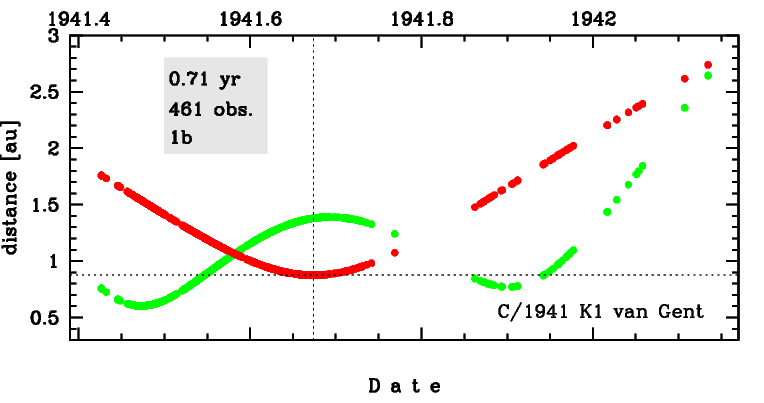C/1941 K1 Van Gent
more info
Comet C/1941 K1 was discovered on 27 May 1941 by Hendrik van Gent (), that is about three months before perihelion passage, and the comet was last seen on 18 February 1942 [Kronk, Cometography: Volume 4].
This comet made its closest approach to the Earth on 21 June 1941 (0.603 au), that is almost a month after its discovery. The next close approach to the Earth was on 24 November (0.771 au).
Solution given here is based on data spanning over 0.710 yr in a range of heliocentric distances from 1.759 au through perihelion (0.875 au) to 2.738 au.
This Oort spike comet suffers small planetary perturbations during its passage through the planetary system and left the planetary zone on a slightly more tight orbit in comparison to its original barycentric orbit (see future barycentric orbit).
More details in Królikowska et al. 2014.
This comet made its closest approach to the Earth on 21 June 1941 (0.603 au), that is almost a month after its discovery. The next close approach to the Earth was on 24 November (0.771 au).
Solution given here is based on data spanning over 0.710 yr in a range of heliocentric distances from 1.759 au through perihelion (0.875 au) to 2.738 au.
This Oort spike comet suffers small planetary perturbations during its passage through the planetary system and left the planetary zone on a slightly more tight orbit in comparison to its original barycentric orbit (see future barycentric orbit).
More details in Królikowska et al. 2014.
| solution description | ||
|---|---|---|
| number of observations | 461 | |
| data interval | 1941 06 04 – 1942 02 18 | |
| data type | perihelion within the observation arc (FULL) | |
| data arc selection | entire data set (STD) | |
| range of heliocentric distances | 1.76 au – 0.88 au (perihelion) – 2.74 au | |
| detectability of NG effects in the comet's motion | NG effects not determinable | |
| type of model of motion | GR - gravitational orbit | |
| data weighting | YES | |
| number of residuals | 801 | |
| RMS [arcseconds] | 2.22 | |
| orbit quality class | 1b | |
| previous orbit statistics, both Galactic and stellar perturbations were taken into account | ||
|---|---|---|
| no. of returning VCs in the swarm | 5001 | * |
| no. of escaping VCs in the swarm | 0 | |
| no. of hyperbolas among escaping VCs in the swarm | 0 | |
| previous reciprocal semi-major axis [10-6 au-1] | 24.01 – 40.76 – 57.30 | |
| previous perihelion distance [au] | 0.92 – 20 – 120 | |
| previous aphelion distance [103 au] | 35 – 49 – 73 | |
| time interval to previous perihelion [Myr] | 2.31 – 2.52 – 2.75 | |
| percentage of VCs with qprev < 10 | 44 | |
| percentage of VCs with 10 < qprev < 20 | 6 | |
| percentage of VCs with qprev > 20 | 50 | |
| previous_g orbit statistics, here only the Galactic tide has been included | ||
|---|---|---|
| no. of returning VCs in the swarm | 5001 | * |
| no. of escaping VCs in the swarm | 0 | |
| no. of hyperbolas among escaping VCs in the swarm | 0 | |
| previous reciprocal semi-major axis [10-6 au-1] | 50.71 – 53.94 – 57.12 | |
| previous perihelion distance [au] | 0.941 – 1.01 – 1.14 | |
| previous aphelion distance [103 au] | 35 – 37.1 – 39.4 | |
| time interval to previous perihelion [Myr] | 2.31 – 2.51 – 2.76 | |
| percentage of VCs with qprev < 10 | 100 | |
